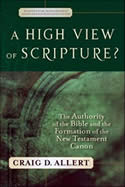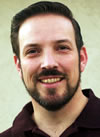Book Review: A High View of Scripture?
Allert, Craig D. A High View of Scripture? The Authority of the Bible and the Formation of the New Testament Canon. Grand Rapids: Baker Academic, 2007. Paperback. 208 pages. $18.99
(Review copy courtesy of Baker Academic.) Purchase: Baker Academic | WTS | CBD | Amazon
Purchase: Baker Academic | WTS | CBD | Amazon
ISBNs: 97808012778 / 0801027780
Read an excerpt.
Series: Evangelical Ressourcement: Ancient Sources for the Church’s Future
Subjects: Biblical Canon, Authority, Inspiration
Craig D. Allert (Ph.D., University of Nottingham) is associate professor and chair of religious studies at Trinity Western University in Langley, British Columbia. He has published journal articles in the area of New Testament canon studies and bibliology and is the author of Revelation, Truth, Canon, and Interpretation.
In A High View of Scripture?, author Craig Allert uses the current interest among evangelicals regarding the canon and its formation as a springboard to challenge evangelical understanding regarding the inspiration and inerrancy of the Bible. The book’s title hints that the traditional view of Scripture may not actually be high enough, since, in Allert’s estimation, it fails to sufficiently weigh the role of the church in canon formation and thus underplays the role of the church in biblical interpretation. In this book, Allert seeks to explore the implications of the “accepted” history of the formation of the canon. (It would be more accurate if he were to say, “The implications of his interpretation of the historical data.”) He writes in the introduction:
This book is about how a historical understanding of the formation of the New Testament canon should inform an evangelical doctrine of Scripture. Briefly stated, this is because the content of the biblical canon, as we know it today, was not a particularly early feature of ancient Christianity: the Bible was not always “there” in early Christianity. Yet, the church still continued to function in its absence. This fact warrants an examination of how this was so. (p. 12)
With this unsubstantiated assertion, he would have us believe in a later (fourth century) view of canon formation, which would place the formation of the Bible more in the hands of the church and thus tilt the divine-human tension of Bibliology decidedly toward the human. The result of this tilt is that the doctrine of inerrancy, as traditionally understood, is again under attack, just as it was in the days of the modernist-fundamentalist controversy of the early twentieth century. He writes:
My position is that a high view of Scripture demands an understanding and integration of the Bible’s very formation. The Bible’s living authority in the life of believers is implicated in this formation because the Bible was formed and grew within the community of faith. This means that the Bible did not drop from heaven but was the result of historical and theological development. (p. 13, emphasis mine)
Perhaps anticipating the objections to this statement, he continues by seeking to allay concerns of a naturalistic view of Scripture. He is careful to assert that he is not denying the supernatural significance and origin of the Bible, and he affirms that he believes the Bible is God’s authoritative revelation to humanity and also that it is the “final source for the believers’ faith and life.” In the anticipation of book reviewers’ negative reactions to his argument, Allert writes:
It is my hope that criticisms of the content of what is offered in this book will deal with the issues raised rather than merely affirming a traditionalistic bibliology as described in chapter 1. I realize that some of the criticisms offered in these pages may give the appearance that I see little good in evangelicalism. In actuality, however, I offer the criticisms and choose to remain within my evangelical framework because I believe it has gotten many things quite right. I identify closely with evangelicalism precisely because its adherents hold the Bible as the ultimate authority for faith and life. (p. 15)
Allert’s argument leads the reader to see the process of canon formation as, essentially, the process of inspiration through the development of the church, rather than viewing inspiration as a singular revelatory event. Throughout the book, he focuses his argument on the function of Scripture and seeks to ascertain its nature in light of this information. In so doing, he ignores Scripture’s own self-attestation as the very revealed Word of God. This is the fatal flaw of the book.
In relation to some of Allert’s critique of evangelical tendencies, the book is thought-provoking and informative (provided one overlooks a slightly sarcastic and somewhat paternalistic approach to those who hold to the “traditional” evangelical view [p. 10]*). He does make several good points that are worth considering.
For instance, he is right when he suggests that over the course of time evangelicals may have actually embraced a tradition of beliefs that they accepted uncritically. Also, his argument rightly points us to consider placing an increased emphasis on validating interpretations with an eye to the community of faith rather than to the lone ranger interpretive tendencies prevalent in modern Christianity.
After his opening critique of Evangelicalism, Allert offers an extended interpretation of historical data that, at most, only makes room for his view. However, the data itself does not exclude equally acceptable viewpoints, and he was unsuccessful in his attempt to convince the reader to abandon the accepted evangelical position on Bibliology.
His view of Scripture, as the product of a process of theological development rather than revelation singularly inspired by God and subsequently recognized by man, belies his repeated assurance that his view is consistent with the understanding that the Bible is the ultimate authority for faith and life. It would be more accurate for Allert to acknowledge that, in his view, the Bible is only the ultimate authority as authoritatively recognized and interpreted by the church (whoever that is). His argument requires that the authority of Scripture and the authority of tradition be placed on equal footing (as if they are actually one in the same thing).
The book concludes with a brief and ineffective treatment of key passages regarding inspiration and inerrancy, and it becomes clear that this is the real target of the study, rather than the canon. He writes:
When it comes to the issue of inspiration, the biblical data are surprisingly vague on a theory of inspiration. They certainly affirm that Scripture is inspired, but how that inspiration functions is not explained. When the biblical passages used to undergird verbal plenary inspiration are understood in light of the later formation of the canon, this should tend to correct some unwarranted presuppositions about what the Bible does and does not say; it also affects the related concept of inerrancy. (pp. 171-172)
Here he tells us that “properly understanding” the doctrine of inspiration is dependent upon our view of the canon formation, so he would lead us to conclude that a later canon formation undermines the traditional view of inspiration and replaces it with a much more modernistic one.
While attempting to remain clothed in Evangelical garb, Allert reveals himself to be the progeny of a long line of men who have set their sights on the view that Scripture is a supernatural revelation of God Himself. This is not a “high view of Scripture” as the title promises. He would have us drop verbal plenary inspiration and inerrancy as defining characteristics of evangelical Christianity and ultimately swallow a sugar-coated modernism in its place.
For those who are interested, I will be posting detailed interaction with Allert’s work, chapter by chapter, on my blog.
____________________
*He characterizes the evangelical view as if the Bible “dropped from the sky.”
 Thomas Pryde has recently started “Sermons in Song,” an itinerate ministry of helps to local churches and is also helping to establish the Veritas School of Theology, an Internet-based distance education program designed to return the locus of theological training to the local church. In his spare time, he continues to help Crossroad’s Baptist Church, a church plant in Tracy, California. He and his wife, Martha Mulfinger Pryde, have five children. Visit his blog at www.neofundamentalist.com. Thomas Pryde has recently started “Sermons in Song,” an itinerate ministry of helps to local churches and is also helping to establish the Veritas School of Theology, an Internet-based distance education program designed to return the locus of theological training to the local church. In his spare time, he continues to help Crossroad’s Baptist Church, a church plant in Tracy, California. He and his wife, Martha Mulfinger Pryde, have five children. Visit his blog at www.neofundamentalist.com. |
- 71 views


Discussion